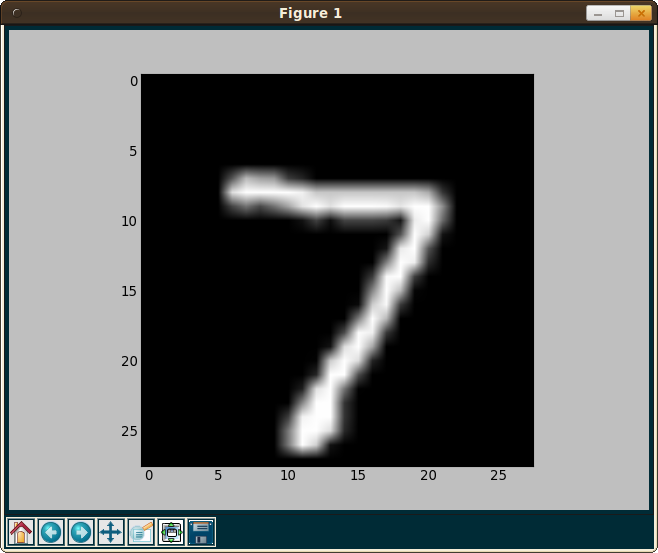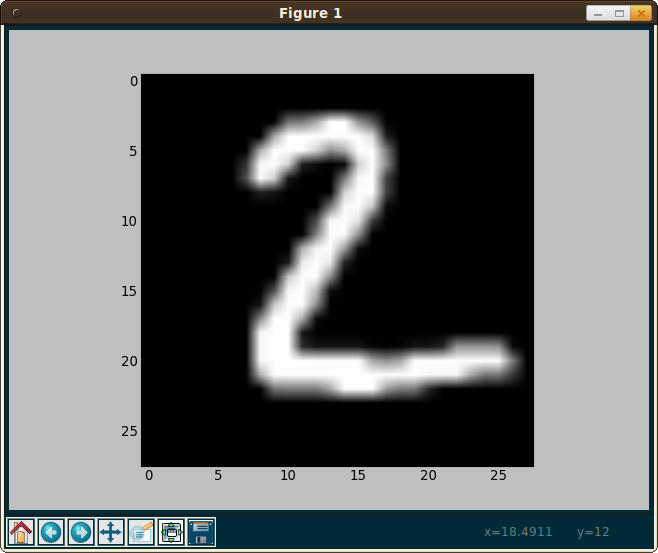The MNIST database is a huge database of handwritten digits that is commonly used for training, evaluating and comparing classifiers.
It has a training set of 60,000 instances and a test set of 10,000 instances. Every instance is a 28 × 28 pixel grayscale image.
The MNIST format
MNIST comes in 4 files (download here):
- train-images-idx3-ubyte.gz: training set images (9.45 MB, 60000 instances)
- train-labels-idx1-ubyte.gz: training set labels (28.2 kB, 60000 labels)
- t10k-images-idx3-ubyte.gz: test set images (1.57 MB, 10000 instances)
- t10k-labels-idx1-ubyte.gz: test set labels (4.43 kB, 10000 labels)
Both label files are like this:
[offset] [type] [value] [description]
0000 32 bit integer 0x00000801(2049) magic number (MSB first)
0004 32 bit integer 60000 number of items
0008 unsigned byte ?? label
0009 unsigned byte ?? label
........
xxxx unsigned byte ?? label
The labels values are 0 to 9.
and both image containers are like that:
[offset] [type] [value] [description]
0000 32 bit integer 0x00000803(2051) magic number
0004 32 bit integer 60000 number of images
0008 32 bit integer 28 number of rows
0012 32 bit integer 28 number of columns
0016 unsigned byte ?? pixel
0017 unsigned byte ?? pixel
........
xxxx unsigned byte ?? pixel
And they are, of course, compressed.
Reading the dataset
Python brings all necessary tools to make it easy to read the dataset:
As the training and the testing dataset is structured the same way, we can create a method thad retrives the data for both files.
from struct import unpack
import gzip
from numpy import zeros, uint8, float32
def get_labeled_data(imagefile, labelfile):
"""Read input-vector (image) and target class (label, 0-9) and return
it as list of tuples.
"""
# Open the images with gzip in read binary mode
images = gzip.open(imagefile, "rb")
labels = gzip.open(labelfile, "rb")
# Read the binary data
# We have to get big endian unsigned int. So we need '>I'
# Get metadata for images
images.read(4) # skip the magic_number
number_of_images = images.read(4)
number_of_images = unpack(">I", number_of_images)[0]
rows = images.read(4)
rows = unpack(">I", rows)[0]
cols = images.read(4)
cols = unpack(">I", cols)[0]
# Get metadata for labels
labels.read(4) # skip the magic_number
N = labels.read(4)
N = unpack(">I", N)[0]
if number_of_images != N:
raise Exception("number of labels did not match the number of images")
# Get the data
x = zeros((N, rows, cols), dtype=float32) # Initialize numpy array
y = zeros((N, 1), dtype=uint8) # Initialize numpy array
for i in range(N):
if i % 1000 == 0:
print("i: %i" % i)
for row in range(rows):
for col in range(cols):
tmp_pixel = images.read(1) # Just a single byte
tmp_pixel = unpack(">B", tmp_pixel)[0]
x[i][row][col] = tmp_pixel
tmp_label = labels.read(1)
y[i] = unpack(">B", tmp_label)[0]
return (x, y)
Viewing data
You might want to take a look at an image. This is easily possible with PyLab (which is a part of Matplotlib):
from pylab import imshow, show, cm
def view_image(image, label=""):
"""View a single image."""
print("Label: %s" % label)
imshow(image, cmap=cm.gray)
show()
It tooks like this:
Classify data
Now we can use PyBrain to classify data.
The following code will first build the PyBrain datastructure for the training set and the testing set. Then it will build a very simple neural network called a Multilayer Perceptron (MLP) with three layers: An input layer, a hidden layer and an output layer.
After creating it, the MLP will be trained with the backpropagation algorithm. Every training step is followed by an evaluation step.
By the way, numpy.ravel
simply flattens a list.
from numpy import ravel
from pybrain.datasets import ClassificationDataSet
from pybrain.utilities import percentError
from pybrain.tools.shortcuts import buildNetwork
from pybrain.supervised.trainers import BackpropTrainer
from pybrain.structure.modules import SoftmaxLayer
def classify(
training,
testing,
HIDDEN_NEURONS,
MOMENTUM,
WEIGHTDECAY,
LEARNING_RATE,
LEARNING_RATE_DECAY,
EPOCHS,
):
trndata = ClassificationDataSet(INPUT_FEATURES, 1, nb_classes=CLASSES)
tstdata = ClassificationDataSet(INPUT_FEATURES, 1, nb_classes=CLASSES)
for i in range(len(testing)):
tstdata.addSample(ravel(testing["x"][i]), [testing["y"][i]])
for i in range(len(trndata)):
trndata.addSample(ravel(trndata["x"][i]), [trndata["y"][i]])
# This is necessary, but I don't know why
# See http://stackoverflow.com/q/8154674/562769
trndata._convertToOneOfMany()
tstdata._convertToOneOfMany()
fnn = buildNetwork(
trndata.indim, HIDDEN_NEURONS, trndata.outdim, outclass=SoftmaxLayer
)
trainer = BackpropTrainer(
fnn,
dataset=trndata,
momentum=MOMENTUM,
verbose=True,
weightdecay=WEIGHTDECAY,
learningrate=LEARNING_RATE,
lrdecay=LEARNING_RATE_DECAY,
)
for i in range(EPOCHS):
trainer.trainEpochs(1)
trnresult = percentError(trainer.testOnClassData(), trndata["class"])
tstresult = percentError(
trainer.testOnClassData(dataset=tstdata), tstdata["class"]
)
print(
"epoch: %4d" % trainer.totalepochs,
" train error: %5.2f%%" % trnresult,
" test error: %5.2f%%" % tstresult,
)
return fnn
Final steps
You might want to add command line parameters, logging and probably pickle the data.
Final complete code
#!/usr/bin/env python
"""Train NN with PyBrain."""
from struct import unpack
import gzip
from numpy import zeros, uint8, float32, ravel
from pylab import imshow, show, cm
from pybrain.datasets import ClassificationDataSet
from pybrain.utilities import percentError
from pybrain.tools.shortcuts import buildNetwork
from pybrain.supervised.trainers import BackpropTrainer
from pybrain.structure.modules import SoftmaxLayer
from argparse import ArgumentParser
import os.path
import cPickle as pickle
def get_labeled_data(imagefile, labelfile, picklename):
"""
Read input-vector (image) and target class (label, 0-9).
Return
------
dict
"""
if os.path.isfile("%s.pickle" % picklename):
data = pickle.load(open("%s.pickle" % picklename))
else:
# Open the images with gzip in read binary mode
images = gzip.open(imagefile, "rb")
labels = gzip.open(labelfile, "rb")
# Read the binary data
# We have to get big endian unsigned int. So we need '>I'
# Get metadata for images
images.read(4) # skip the magic_number
number_of_images = images.read(4)
number_of_images = unpack(">I", number_of_images)[0]
rows = images.read(4)
rows = unpack(">I", rows)[0]
cols = images.read(4)
cols = unpack(">I", cols)[0]
# Get metadata for labels
labels.read(4) # skip the magic_number
N = labels.read(4)
N = unpack(">I", N)[0]
if number_of_images != N:
raise Exception(
"The number of labels did not match " "the number of images."
)
# Get the data
x = zeros((N, rows, cols), dtype=float32) # Initialize numpy array
y = zeros((N, 1), dtype=uint8) # Initialize numpy array
for i in range(N):
if i % 1000 == 0:
print("i: %i" % i)
for row in range(rows):
for col in range(cols):
tmp_pixel = images.read(1) # Just a single byte
tmp_pixel = unpack(">B", tmp_pixel)[0]
x[i][row][col] = float(tmp_pixel) / 255
tmp_label = labels.read(1)
y[i] = unpack(">B", tmp_label)[0]
data = {"x": x, "y": y, "rows": rows, "cols": cols}
pickle.dump(data, open("%s.pickle" % picklename, "wb"))
return data
def view_image(image, label=""):
"""View a single image."""
print("Label: %s" % label)
imshow(image, cmap=cm.gray)
show()
def classify(
training,
testing,
HIDDEN_NEURONS,
MOMENTUM,
WEIGHTDECAY,
LEARNING_RATE,
LEARNING_RATE_DECAY,
EPOCHS,
):
INPUT_FEATURES = testing["rows"] * testing["cols"]
print("Input features: %i" % INPUT_FEATURES)
CLASSES = 10
trndata = ClassificationDataSet(INPUT_FEATURES, 1, nb_classes=CLASSES)
tstdata = ClassificationDataSet(INPUT_FEATURES, 1, nb_classes=CLASSES)
for i in range(len(testing["x"])):
tstdata.addSample(ravel(testing["x"][i]), [testing["y"][i]])
for i in range(len(training["x"])):
trndata.addSample(ravel(training["x"][i]), [training["y"][i]])
# This is necessary, but I don't know why
# See http://stackoverflow.com/q/8154674/562769
trndata._convertToOneOfMany()
tstdata._convertToOneOfMany()
fnn = buildNetwork(
trndata.indim, HIDDEN_NEURONS, trndata.outdim, outclass=SoftmaxLayer
)
trainer = BackpropTrainer(
fnn,
dataset=trndata,
momentum=MOMENTUM,
verbose=True,
weightdecay=WEIGHTDECAY,
learningrate=LEARNING_RATE,
lrdecay=LEARNING_RATE_DECAY,
)
print("Start training")
for i in range(EPOCHS):
trainer.trainEpochs(1)
trnresult = percentError(trainer.testOnClassData(), trndata["class"])
tstresult = percentError(
trainer.testOnClassData(dataset=tstdata), tstdata["class"]
)
print(
"epoch: %4d" % trainer.totalepochs,
" train error: %5.2f%%" % trnresult,
" test error: %5.2f%%" % tstresult,
)
return fnn
if __name__ == "__main__":
parser = ArgumentParser()
# Add more options if you like
parser.add_argument(
"-H",
metavar="H",
type=int,
dest="hidden_neurons",
default=200,
help="number of neurons in the hidden layer",
)
parser.add_argument(
"-e",
metavar="EPOCHS",
type=int,
dest="epochs",
default=20,
help="number of epochs to learn",
)
parser.add_argument(
"-d",
metavar="W",
type=float,
dest="weightdecay",
default=0.01,
help="weightdecay",
)
parser.add_argument(
"-m", metavar="M", type=float, dest="momentum", default=0.1, help="momentum"
)
parser.add_argument(
"-l",
metavar="ETA",
type=float,
dest="learning_rate",
default=0.01,
help="learning rate",
)
parser.add_argument(
"-ld",
metavar="ALPHA",
type=float,
dest="lrdecay",
default=1,
help="learning rate decay",
)
args = parser.parse_args()
print("Get testset")
testing = get_labeled_data(
"t10k-images-idx3-ubyte.gz", "t10k-labels-idx1-ubyte.gz", "testing"
)
print("Got %i testing datasets." % len(testing["x"]))
print("Get trainingset")
training = get_labeled_data(
"train-images-idx3-ubyte.gz", "train-labels-idx1-ubyte.gz", "training"
)
print("Got %i training datasets." % len(training["x"]))
classify(
training,
testing,
args.hidden_neurons,
args.momentum,
args.weightdecay,
args.learning_rate,
args.lrdecay,
args.epochs,
)
Results
I'll update that tomorrow:
python pybrainmnist.py
Get testset
Got 10000 testing datasets.
Get trainingset
Got 60000 training datasets.
Input features: 784
Start training
Total error: 0.0132789873631
('epoch: 1', ' train error: 14.97%', ' test error: 14.28%')
Total error: 0.0122669294279
('epoch: 2', ' train error: 11.54%', ' test error: 11.18%')
Total error: 0.0121586496637
('epoch: 3', ' train error: 12.21%', ' test error: 11.71%')
Total error: 0.0121439024528
('epoch: 4', ' train error: 13.91%', ' test error: 13.01%')
Total error: 0.0121144144187
('epoch: 5', ' train error: 12.51%', ' test error: 11.95%')
Total error: 0.0121177344402
('epoch: 6', ' train error: 12.14%', ' test error: 11.35%')
Total error: 0.0121240818924
('epoch: 7', ' train error: 15.82%', ' test error: 15.38%')
Total error: 0.0120871124447
('epoch: 8', ' train error: 13.00%', ' test error: 12.32%')
Total error: 0.0120638692784
('epoch: 9', ' train error: 14.02%', ' test error: 13.06%')
Total error: 0.0120865053396
('epoch: 10', ' train error: 13.42%', ' test error: 12.79%')
Total error: 0.0120843528845
('epoch: 11', ' train error: 13.42%', ' test error: 13.02%')
Total error: 0.0120598288441
('epoch: 12', ' train error: 13.08%', ' test error: 12.33%')
Total error: 0.0120947755501
('epoch: 13', ' train error: 12.86%', ' test error: 12.36%')
Total error: 0.0120686450925
('epoch: 14', ' train error: 13.21%', ' test error: 12.34%')
Total error: 0.0120948253309
('epoch: 15', ' train error: 12.53%', ' test error: 11.64%')
Total error: 0.0120471256247
('epoch: 16', ' train error: 13.71%', ' test error: 12.88%')
Total error: 0.0120735887868
('epoch: 17', ' train error: 12.78%', ' test error: 11.81%')
Total error: 0.0120712301982
('epoch: 18', ' train error: 13.66%', ' test error: 13.13%')
Total error: 0.0120947124816
('epoch: 19', ' train error: 12.48%', ' test error: 11.79%')
Total error: 0.0120736808357
('epoch: 20', ' train error: 14.52%', ' test error: 13.95%')
real 3745,91s
user 7336,48s
sys 21571,09s

